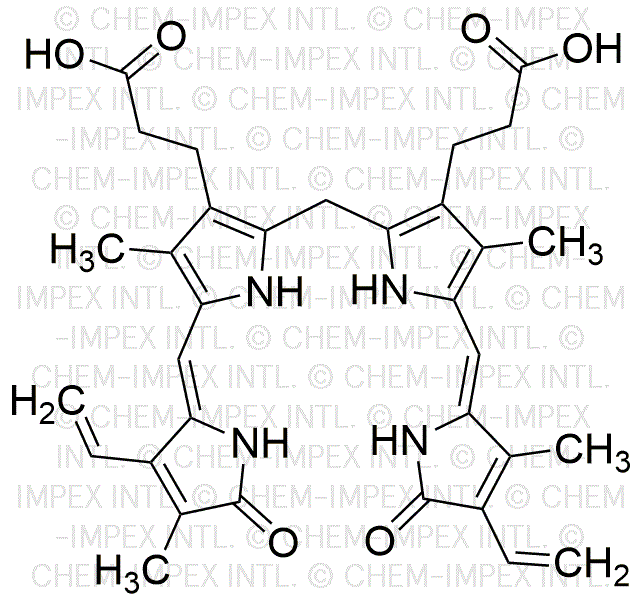Bilirubin is widely utilized in research focused on:
- Medical Diagnostics: It is a key biomarker for liver function tests, helping to diagnose conditions like jaundice and liver disease by measuring bilirubin levels in the blood.
- Phototherapy for Neonatal Jaundice: Bilirubin is used in phototherapy treatments for newborns with high bilirubin levels, effectively reducing the risk of complications from jaundice.
- Antioxidant Research: Its properties are being studied for potential antioxidant effects, which could lead to applications in preventing oxidative stress-related diseases.
- Drug Development: Bilirubin derivatives are being explored in the development of new pharmaceuticals, particularly in anti-inflammatory and neuroprotective therapies.
- Biomaterials: Its potential use in creating biocompatible materials for medical applications is being researched, particularly for wound healing and tissue engineering.
Informations générales
Propriétés
Sécurité et réglementation
Applications
Bilirubin is widely utilized in research focused on:
- Medical Diagnostics: It is a key biomarker for liver function tests, helping to diagnose conditions like jaundice and liver disease by measuring bilirubin levels in the blood.
- Phototherapy for Neonatal Jaundice: Bilirubin is used in phototherapy treatments for newborns with high bilirubin levels, effectively reducing the risk of complications from jaundice.
- Antioxidant Research: Its properties are being studied for potential antioxidant effects, which could lead to applications in preventing oxidative stress-related diseases.
- Drug Development: Bilirubin derivatives are being explored in the development of new pharmaceuticals, particularly in anti-inflammatory and neuroprotective therapies.
- Biomaterials: Its potential use in creating biocompatible materials for medical applications is being researched, particularly for wound healing and tissue engineering.
Documents
Fiches de données de sécurité (FDS)
La FDS fournit des informations de sécurité complètes sur la manipulation, le stockage et l’élimination du produit.
Spécifications du produit (PS)
Le PS fournit une description complète des propriétés du produit, notamment sa composition chimique, son état physique, sa pureté et les exigences de stockage. Il détaille également les plages de qualité acceptables et les applications prévues du produit.
Certificats d'analyse (COA)
Recherchez des certificats d'analyse (COA) en saisissant le numéro de lot du produit. Les numéros de lot et de lot se trouvent sur l'étiquette d'un produit, après les mots « Lot » ou « Lot de fabrication ».
Numéro de catalogue
Numéro de lot/série
Certificats d'origine (COO)
Ce certificat d'exploitation confirme le pays dans lequel le produit a été fabriqué, et détaille également les matériaux et composants utilisés et s'il est issu de sources naturelles, synthétiques ou autres sources spécifiques. Ce certificat peut être requis pour les douanes, le commerce et la conformité réglementaire.
Numéro de catalogue
Numéro de lot/série
Fiches de données de sécurité (FDS)
La FDS fournit des informations de sécurité complètes sur la manipulation, le stockage et l’élimination du produit.
DownloadSpécifications du produit (PS)
Le PS fournit une description complète des propriétés du produit, notamment sa composition chimique, son état physique, sa pureté et les exigences de stockage. Il détaille également les plages de qualité acceptables et les applications prévues du produit.
DownloadCertificats d'analyse (COA)
Recherchez des certificats d'analyse (COA) en saisissant le numéro de lot du produit. Les numéros de lot et de lot se trouvent sur l'étiquette d'un produit, après les mots « Lot » ou « Lot de fabrication ».
Numéro de catalogue
Numéro de lot/série
Certificats d'origine (COO)
Ce certificat d'exploitation confirme le pays dans lequel le produit a été fabriqué, et détaille également les matériaux et composants utilisés et s'il est issu de sources naturelles, synthétiques ou autres sources spécifiques. Ce certificat peut être requis pour les douanes, le commerce et la conformité réglementaire.


